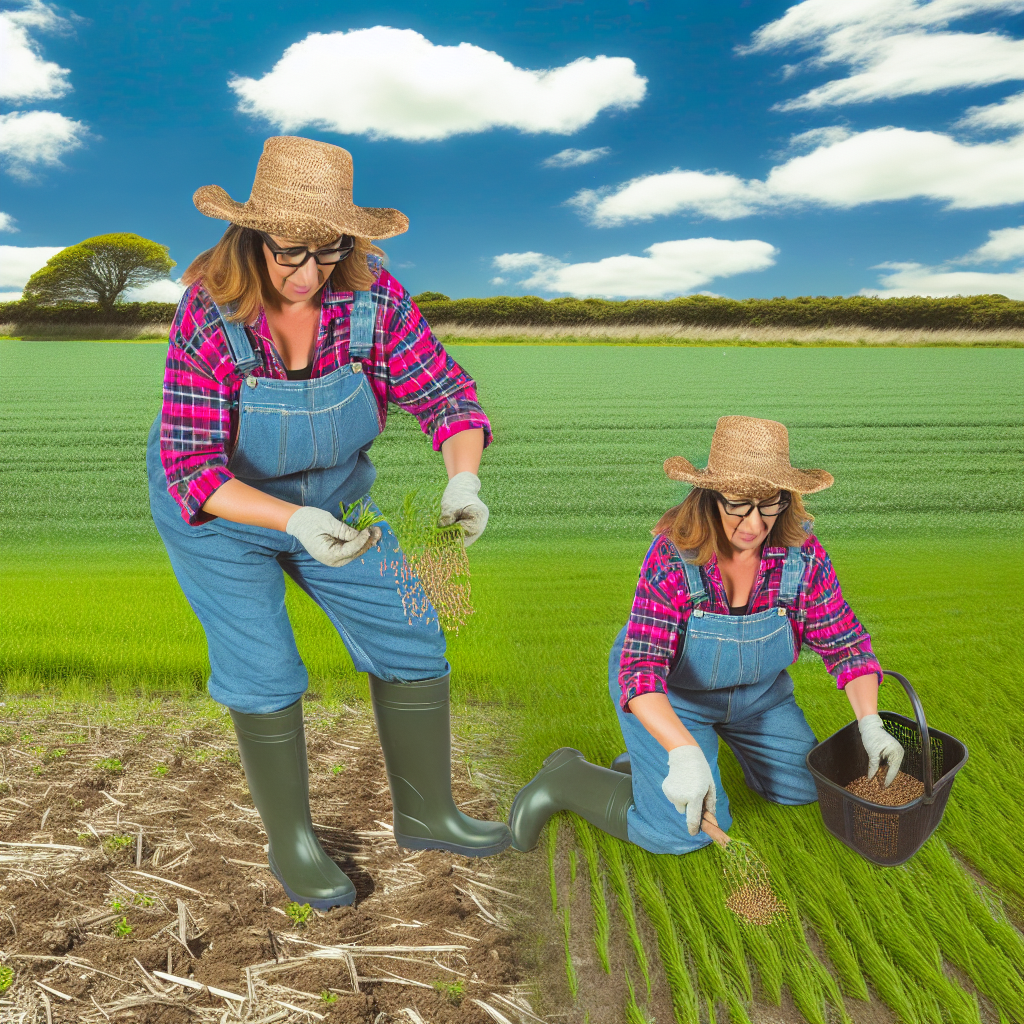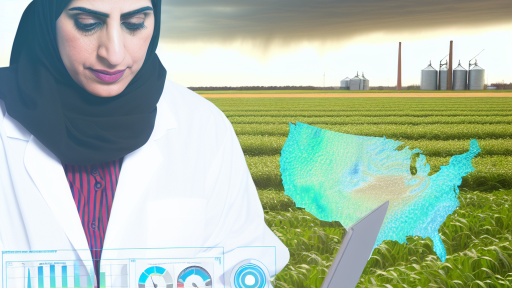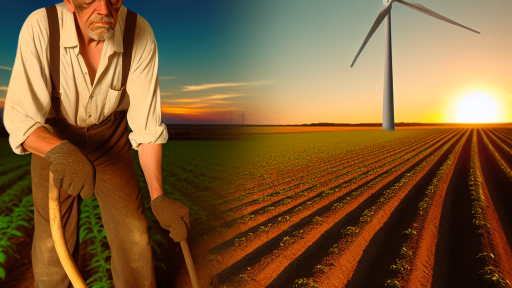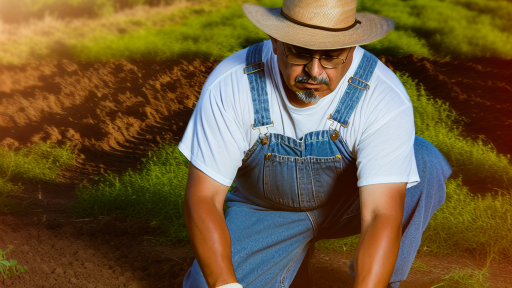Introduction to Cover Crops
Definition of Cover Crops
Cover crops are plants grown primarily for soil health benefits.
They protect and enrich the soil during periods of fallow.
Farmers typically plant cover crops between main crop cycles.
These crops can include legumes, grasses, and other species.
Importance of Cover Crops in Agriculture
Cover crops play an essential role in sustainable farming practices.
They improve soil structure and prevent erosion.
Moreover, they enhance soil fertility through nutrient cycling.
Farmers benefit from reduced weed pressures and improved water management.
Varieties of Cover Crops
There are several popular varieties of cover crops available.
Leguminous cover crops, such as clover, fix nitrogen in the soil.
Grassy options, like rye, help in reducing soil erosion.
Other types, including brassicas, suppress weeds effectively.
Cover Crop Practices
Farmers can employ various practices for effective cover cropping.
Selecting the right species based on local climate is vital.
Timing the planting and termination of cover crops is crucial.
Transform Your Agribusiness
Unlock your farm's potential with expert advice tailored to your needs. Get actionable steps that drive real results.
Get StartedConsistent monitoring helps in managing cover crop health.
Overview of Greenhouse Gas Emissions in Agriculture
Agriculture significantly contributes to greenhouse gas emissions worldwide.
In fact, agricultural activities such as livestock production and fertilizer use account for a large portion of total emissions.
Understanding these emissions is critical for effective climate change mitigation.
Major Sources of Emissions
The primary greenhouse gases emitted from agriculture are carbon dioxide, methane, and nitrous oxide.
Carbon dioxide mainly results from soil degradation and deforestation.
Meanwhile, methane emissions primarily stem from enteric fermentation in ruminants.
Additionally, nitrous oxide is released from the application of synthetic fertilizers.
The Impact of Livestock
Livestock farming is a notable source of methane emissions.
Cows and sheep produce significant amounts of methane during digestion.
This process, known as enteric fermentation, contributes greatly to global warming.
The Role of Fertilizers
Fertilizers are essential for crop production but can lead to substantial nitrous oxide emissions.
When nitrogen-based fertilizers are applied, they can release this potent greenhouse gas into the atmosphere.
Thus, managing fertilizer use is key to reducing agriculture’s carbon footprint.
The Importance of Land Use Changes
Land-use changes such as deforestation for agriculture can cause severe carbon emissions.
When forests are cleared, significant amounts of stored carbon dioxide are released into the atmosphere.
Preserving existing forests is vital for maintaining carbon storage.
Global Efforts to Reduce Emissions
Numerous countries are implementing strategies to reduce agricultural emissions.
These strategies include promoting sustainable farming practices and efficient resource use.
Additionally, international agreements focus on reducing agriculture’s environmental impact.
The Role of Cover Crops in Improving Soil Health
Enhancing Soil Structure
Cover crops contribute significantly to soil structure improvement.
They add organic matter to the soil through decomposition.
This organic matter enhances soil aggregation and porosity.
As a result, improved soil structure promotes better water infiltration.
Showcase Your Farming Business
Publish your professional farming services profile on our blog for a one-time fee of $200 and reach a dedicated audience of farmers and agribusiness owners.
Publish Your ProfileAdditionally, it helps reduce soil erosion.
Boosting Soil Fertility
Leguminous cover crops fix nitrogen in the soil.
This natural nitrogen enrichment supports the growth of subsequent crops.
Moreover, these crops can minimize the need for chemical fertilizers.
As a consequence, farmers can reduce operational costs.
Enhancing Microbial Activity
Cover crops stimulate beneficial microbial activity in the soil.
This activity is vital for nutrient cycling and plant health.
It contributes to a diverse soil ecosystem.
In turn, this diversity enhances resilience against diseases.
Preventing Soil Compaction
Well-developed root systems of cover crops help prevent soil compaction.
Roots create channels that enhance air and water movement.
Better aeration supports root development in subsequent crops.
Integrating Cover Crops in Crop Rotation
Integrating cover crops into crop rotations promotes long-term soil health.
They break pest and disease cycles naturally.
This rotation also improves soil nutrient balance.
Implications of Cover Crops on Sustainable Agriculture
Implementing cover crops leads to sustainable soil health benefits.
Farmers can witness increased productivity and environmental resilience.
Ultimately, cover crops play a critical role in sustainable agriculture.
Gain More Insights: Building Resilient Farms Against Climate-Induced Floods
How Cover Crops Contribute to Carbon Sequestration
Understanding Carbon Sequestration
Carbon sequestration refers to capturing atmospheric carbon dioxide.
This process helps to reduce greenhouse gases in the atmosphere.
Cover crops play a crucial role in this carbon management strategy.
Cover Crops Enhance Soil Health
Healthy soil actively absorbs carbon from the atmosphere.
Cover crops improve soil structure and increase organic matter.
As a result, they enhance the soil’s ability to store carbon.
Promoting Root Growth
Cover crops develop extensive root systems beneath the soil.
These roots help to stabilize soil and prevent erosion.
Furthermore, they deposit organic carbon in the soil as they decay.
Increasing Biodiversity in Agriculture
Cover crops foster a diverse ecosystem in agricultural fields.
This diversity supports various microorganisms that aid in carbon storage.
Additionally, healthier ecosystems enhance overall agricultural resilience.
Reducing Soil Disturbance
Minimizing soil disturbance is vital for effective carbon sequestration.
Cover crops can be grown in conjunction with reduced tillage practices.
As a result, they help maintain soil integrity and enhance carbon storage.
Impact and Benefits of Cover Crops
Cover crops significantly contribute to carbon sequestration.
They improve soil health, foster biodiversity, and stabilize ecosystems.
Using cover crops can mitigate climate change effects.
Uncover the Details: Adapting Agriculture to Climate Change Effectively
The Impact of Cover Crops on Nitrogen Cycling and Reduction of Nitrous Oxide Emissions
Understanding Nitrogen Cycling
Nitrogen cycling is crucial for soil health and fertility.
It involves various processes including fixation, nitrification, and denitrification.
Showcase Your Farming Business
Publish your professional farming services profile on our blog for a one-time fee of $200 and reach a dedicated audience of farmers and agribusiness owners.
Publish Your ProfileCover crops play an essential role in this cycle.
They can enhance nitrogen availability in the soil.
Moreover, they help to stabilize nitrogen levels during off-seasons.
Cover Crops and Nitrous Oxide Emissions
Nitrous oxide is a potent greenhouse gas.
It is emitted during nitrogen cycling processes, particularly denitrification.
Cover crops can significantly reduce nitrous oxide emissions.
They do this by enhancing microbial activity in the soil.
Increased microbial activity promotes more efficient nitrogen utilization.
Strategies for Effective Use of Cover Crops
Choosing the right species of cover crops is vital.
Leguminous plants, like clover, are excellent choices.
They fix atmospheric nitrogen, enriching the soil naturally.
Additionally, implementing cover crops in rotation can yield significant benefits.
Farmers can use diverse cover crops to improve soil structure and health.
Real-World Examples and Benefits
Many farmers have reported success using cover crops.
For instance, Taylor Farms saw a notable decrease in nitrogen runoff.
This led to lower nitrous oxide emissions as well.
Furthermore, cover crops can improve water retention in the soil.
This helps enhance overall crop productivity.
Challenges and Considerations
Despite their benefits, cover crops require careful management.
Farmers may face challenges in selecting suitable species.
Additionally, establishing cover crops can increase upfront costs.
However, the long-term benefits often outweigh these initial investments.
Proper planning is essential for maximizing their advantages.
Learn More: Farming Resilience: Adaptation Strategies That Work

Case Studies of Successful Cover Crop Implementation for Gas Mitigation
Introduction to Cover Crops
Cover crops play a vital role in sustainable agriculture.
They enhance soil health and reduce greenhouse gas emissions.
Farmers can implement cover crops effectively to improve their land.
Case Study: Johnson Family Farm
Located in Iowa, Johnson Family Farm adopted cover crops in 2018.
They achieved significant reductions in nitrogen runoff.
As a result, their water quality improved noticeably.
Additionally, the soil structure became more resilient.
Farmers reported better yields in subsequent crops.
Case Study: Green Valley Organic Farms
Green Valley Organic Farms in California implemented cover crops in 2020.
The farm utilized a mix of legumes and brassicas for nitrogen fixation.
This strategy reduced the need for chemical fertilizers.
Furthermore, erosion decreased significantly during heavy rains.
Data indicated an overall improvement in soil organic matter.
Case Study: Smith & Sons Ranch
Smith & Sons Ranch in Texas embraced diverse cover cropping in 2019.
They rotated various species to enhance biodiversity.
By doing so, they mitigated soil compaction and enhanced water retention.
Showcase Your Farming Business
Publish your professional farming services profile on our blog for a one-time fee of $200 and reach a dedicated audience of farmers and agribusiness owners.
Publish Your ProfileThis led to better crop performance during dry spells.
Farmers also noticed a decrease in overall pest populations.
Lessons Learned from These Case Studies
Cover crops require careful planning and management.
Farmers must choose the right species for their specific conditions.
Monitoring results is essential for continuous improvement.
Additionally, education on best practices enhances adoption rates.
These case studies demonstrate the effectiveness of cover crops in gas mitigation.
Learn More: Creating Buffer Zones to Protect Farms from Flooding
Challenges and Barriers to Adopting Cover Crops Among Farmers
Economic Concerns
Farmers often face high initial costs when adopting cover crops.
These expenses include seeds, planting, and maintenance.
Additionally, potential yield reductions during the transition period pose a significant concern.
Farmers may worry about the financial implications of these factors.
Access to funding or subsidies can also be limited.
Knowledge and Education Gaps
An understanding of cover crop benefits is not widespread among farmers.
Many farmers may lack access to educational resources.
Training programs tailored to local conditions can be scarce.
Additionally, misinformation can discourage adoption.
Consequently, farmers may hesitate to change established practices.
Perceived Risk and Uncertainty
Farmers often perceive a high level of risk in adopting new practices.
Uncertainty about market demands and weather conditions can exacerbate this risk.
Furthermore, success stories of cover crop use may not be well-publicized.
This lack of visibility can lead to skepticism about effectiveness.
As a result, farmers may prefer conventional methods over experimentation.
Cultural and Social Factors
Tradition plays a significant role in farming practices.
Many farmers feel a strong attachment to established routines.
Peer influence can also impact decisions regarding cover crop adoption.
If local farms do not adopt these practices, others may follow suit.
Social norms and community beliefs can thus hinder progress.
Policy and Regulatory Barriers
Government regulations may not always support cover crop implementation.
Policies can impose restrictions that complicate the adoption process.
Farmers may also encounter difficulties in understanding these regulations.
This complexity can lead to frustration and further reluctance.
Collaboration between policymakers and farmers is essential for positive change.
Future Trends and Research Directions for Cover Crops and Climate Change Mitigation
Innovative Research Approaches
Research institutions are exploring innovative methods to enhance cover crop effectiveness.
For instance, studies focus on integrating advanced genetic traits in cover crops.
These traits could improve resilience to climate variations.
Moreover, researchers are utilizing technology such as remote sensing.
This technology helps monitor soil health and crop performance in real-time.
Interdisciplinary Collaboration
Future research will emphasize collaboration among various scientific fields.
Agroecologists, soil scientists, and climate experts will work together.
Showcase Your Farming Business
Publish your professional farming services profile on our blog for a one-time fee of $200 and reach a dedicated audience of farmers and agribusiness owners.
Publish Your ProfileSuch teamwork can lead to holistic solutions for climate change mitigation.
Additionally, partnerships with agricultural practitioners are essential.
This collaboration ensures that research aligns with practical farming needs.
Policy and Economic Incentives
Government policies will increasingly support cover crop adoption.
Economic incentives will encourage farmers to implement sustainable practices.
Financial programs might include grants for cover crop research and implementation.
Taxes or subsidies could also promote environmentally friendly farming methods.
These incentives will lead to increased awareness and participation in cover cropping.
Long-term Sustainability Goals
Research will align with global sustainability goals set by organizations.
Efforts will integrate cover crops into broader climate action plans.
Additionally, long-term studies will assess cover crops’ impacts on soil carbon sequestration.
Such assessments will provide data for future agricultural policies.
This approach aims to create resilient farming systems for future generations.
Adoption of Technological Advances
Farmers will increasingly use precision agriculture technologies.
These tools can help select suitable cover crop species for specific conditions.
Furthermore, advancements in data analytics will enhance decision-making processes.
Farmers will benefit from personalized advice based on their unique circumstances.
Such technology will facilitate more effective cover crop management.
Additional Resources
Cover Cropping to Improve Climate Resilience | USDA Climate Hubs
Cover crops may be used to mitigate and adapt to climate change …




